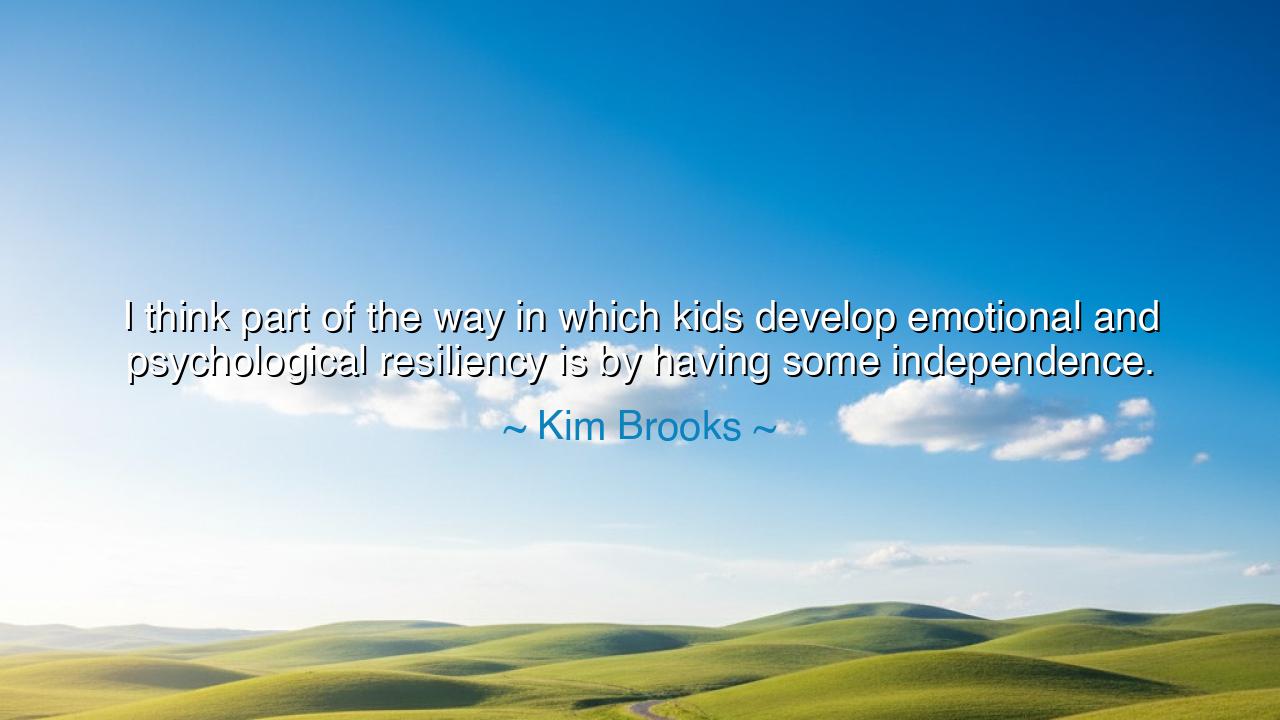
I think part of the way in which kids develop emotional and
I think part of the way in which kids develop emotional and psychological resiliency is by having some independence.






“I think part of the way in which kids develop emotional and psychological resiliency is by having some independence.” Thus spoke Kim Brooks, a writer and mother who came to understand through trial and reflection what generations of wise teachers have long known — that strength of the soul is not born of protection, but of freedom. In this simple yet profound truth lies the secret of resilience, that inner armor which shields the spirit not by sheltering it from hardship, but by teaching it to endure, to adapt, and to rise.
To understand her meaning, one must remember the world that shaped her words. Brooks became a voice for parents and children after a moment of controversy — an act born of ordinary trust, when she left her young child in a locked car for a few minutes while running an errand, only to face public outrage and legal consequences. From that experience, she came to see how deeply modern society has grown afraid — afraid of risk, of autonomy, of letting children breathe the air of self-reliance. Her words, then, are not merely advice to parents, but a call to an age that has forgotten that independence is the root of resilience, and that a child overprotected becomes an adult unprepared for the storms of life.
The ancients, too, understood this sacred balance between freedom and care. The philosophers of Greece taught that virtue cannot be inherited — it must be learned through challenge. The young Spartans, trained in the agoge, were not hardened to cruelty, but prepared for reality; they were taught that to live freely, one must first learn to stand alone. Likewise, the Romans believed that character was forged in the crucible of effort, not ease. For how can courage be known if the heart has never faced fear? How can self-reliance bloom if every path has been cleared before the child’s feet? So too does Brooks remind us that overprotection, though born of love, can become the very chain that stifles growth.
Consider the story of Eleanor Roosevelt, who as a young girl suffered loss, loneliness, and rejection. Yet through those trials, she discovered the strength that would one day make her one of the most powerful voices for human rights. “You gain strength, courage, and confidence,” she once said, “by every experience in which you really stop to look fear in the face.” Her resilience was not a gift bestowed upon her by others — it was the fruit of her own independence, the courage to confront pain and transform it into purpose. So it is for every child: the shield of resilience is not forged by those who protect them from the world, but by those who trust them to meet the world with their own hands and hearts.
Brooks’s insight touches upon a quiet tragedy of modern life — that in seeking to make childhood safer, we have often made it smaller. The fields where children once roamed have been replaced by screens, their laughter confined by fear, their curiosity measured in supervised doses. Yet a child who never risks a fall never learns to rise. Emotional and psychological resiliency cannot be taught through words or caution alone; it is built through experience — through scraped knees, failed plans, moments of solitude, and the quiet triumphs of problem-solving. The spirit, like the muscle, strengthens only when it is allowed to stretch, to strain, to discover its own strength.
But independence is not abandonment. To grant a child independence is not to leave them untended, but to show them trust — to whisper to them, “You are capable.” In this act, we plant the seed of confidence, the belief that even when we are not there to guide them, they can still find their way. This is the essence of resiliency: not the absence of hardship, but the knowledge that one can endure it. The wise parent, the wise teacher, understands that the greatest gift to a child is not a shield against the world, but the courage to step into it unafraid.
So, my child of tenderness and strength, take this lesson deeply to heart: do not fear the discomfort that shapes you. For in every stumble lies a lesson, and in every challenge, a chance to grow. If you are a parent, let your love be bold enough to trust your child’s independence. If you are a child of the world, let your courage guide you through the unknown. Remember, the oak tree stands tall not because it was spared the wind, but because it learned to root itself deeper each time the storm came.
Thus, as Kim Brooks teaches, independence is not the opposite of love — it is its truest expression. To grant freedom is to express faith; to allow challenge is to cultivate strength. Let the young wander, let them wonder, and let them fall — for in rising, they will learn the great secret of life: that resilience is not given; it is earned. And in that earning, the soul becomes free.






AAdministratorAdministrator
Welcome, honored guests. Please leave a comment, we will respond soon